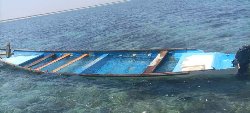Seagrass declining worldwide, threatening wildlife
Seagrass declining worldwide, threatening wildlife - UN environment agency
Some 15 per cent of the entire world's seagrass has been lost in the past 10 years, putting at greater risks already threatened manatees and sea turtles, the United Nations Environmental Programme (UNEP) said today.
In a press release issued in London and Nairobi, UNEP said the seagrass meadows were being diminished by "runoff of nutrients and sediments from human activities on land, boating, land reclamation and other construction in the coastal zone, dredge-and-fill activities and destructive fisheries practices."
The findings were published Monday in the World Atlas of Seagrasses, prepared by UNEP's World Conservation Monitoring Centre (WCMC). The agency estimates that the total area of seagrass meadows is now about 177,000 square kilometres, an area just two-thirds the size of the United Kingdom.
"We now have a global, scientific view of where seagrasses occur and what is happening to them," said Klaus Toepfer, UNEP Executive Director. "Unfortunately, the scientists have presented us with a worrying story. In many cases, these vitally important undersea meadows are being needlessly destroyed for short-term gain without a true understanding of their significance."
Seagrasses are a mixed group of true flowering plants - not seaweed - that grow submerged in large meadows in both tropical and temperate seas. According to UNEP, besides manatees and sea turtles, thousands more associated marine plant and animal species utilize seagrass habitat.
According to the new Atlas, seagrass meadows should be considered one of the most important shallow marine ecosystems to humans, playing a vital role in fisheries, protecting coral reefs by binding sediments, cleaning coastal waters and providing coastal defence from erosion.
"Seagrass beds have been needlessly destroyed for short-term gain without real analysis of the values that the intact ecosystems bring to coastal society," said Mark Collins, Director of UNEP-WCMC. "Physically they protect coastlines from the erosive impact of waves and tides, chemically they play a key role in nutrient cycles for fisheries and biologically they provide habitat for fish, shellfish and priority ecotourism icons like the dugong, manatee and green turtle. And yet, despite these important attributes, they have been overlooked by conservationists and coastal development planners throughout their range."


 UN News: Ceasefire The Only Way To End Killing And Injuring Of Children In Gaza
UN News: Ceasefire The Only Way To End Killing And Injuring Of Children In Gaza ICHRP: US-Japan-Philippines Trilateral Summit Makes The Philippines A Battlefield For US-China Conflict
ICHRP: US-Japan-Philippines Trilateral Summit Makes The Philippines A Battlefield For US-China Conflict East West Center: Environmental Journalist Alexander Kaufman Receives East-West Center’s Inaugural Melvin M.S. Goo Writing Fellowship
East West Center: Environmental Journalist Alexander Kaufman Receives East-West Center’s Inaugural Melvin M.S. Goo Writing Fellowship Compassion in World Farming: Octopus Farm Must Be Stopped, Say Campaigners
Compassion in World Farming: Octopus Farm Must Be Stopped, Say Campaigners UN News: Shipwreck Tragedy Off Djibouti Coast, Drone Attacks Continue At Ukraine Nuclear Plant, Madagascar Cyclone Update
UN News: Shipwreck Tragedy Off Djibouti Coast, Drone Attacks Continue At Ukraine Nuclear Plant, Madagascar Cyclone Update UN News: Aid Lifeline Reaches Sudan's Darfur Region In Bid To Avert ‘Hunger Catastrophe’
UN News: Aid Lifeline Reaches Sudan's Darfur Region In Bid To Avert ‘Hunger Catastrophe’